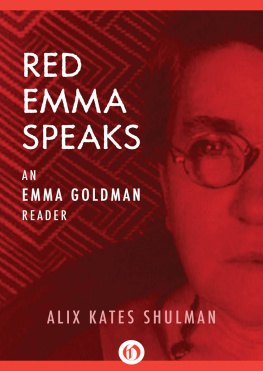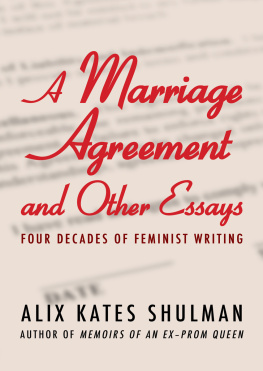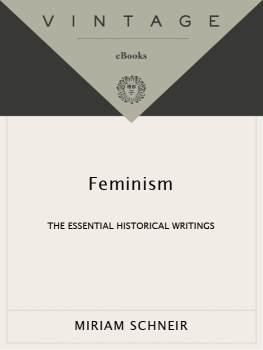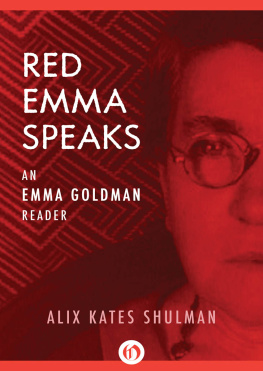Red Emma Speaks
An Emma Goldman Reader
Third Edition
Compiled and Edited by
Alix Kates Shulman

F OR M ARGARET F LUTE AND N AOMI
W EISSTEIN, IN WHOM E MMAS SPIRIT
LIVES ON.

Foreword to the
1996 Edition
As the twentieth century winds down, one of its most fascinating characters, Emma Goldman (18691940), after decades of bleak obscurity following her death, is once again a vital forceat least among feminists, leftists, and devotees of U.S. history. In the wake of the second wave of feminism, which embraced Goldman as a hero, she and her works have been studied, researched, archived, and enshrined on microfilm in libraries throughout the world. Dr. Candace Falk and her staff at the Emma Goldman Papers Project of the University of California at Berkeley have labored for more than a decade to collect and archive every last scrap of Goldman manuscript, correspondence, likeness, and memorabilia that might illuminate her lifeincluding even her personal recipe for blintzes. As a result of this work of devotion and scholarship, Red Emma Goldman now presides over a permanent banquet in scholar heaven.
Yet the hungers of ordinary readers who may wish to savor Goldmans work are different from those of the specialized scholar. It is to such readers that I offer Red Emma Speaksstill the only work I know to present in a single handy volume the full sweep of Goldmans opinions and personality. In addition to nine essays Goldman herself selected for her 1910 Anarchism and Other Essays (New York: Mother Earth Publishing Co.), three dramatic sections from her autobiography, Living My Life (New York: Alfred A. Knopf, 1931), and the afterword to her My Disillusionment in Russia (New York: Doubleday, Page & Co., 1923, 1924), which the collapse of the Soviet Union has revealed as prescient, there are sixteen more pieces covering a great range of subjects, together here for the first time and offering, I believe, a rich borscht of Goldmans life and thought.
The first edition of Red Emma Speaks (1972), with its biographical sketch, introduced Goldman to a new generation. The second edition (1985), enlarged to serve an exploding interest in womens studies, added three more essays plus my own assessment of Goldmans feminism. The present, third edition (1996) has been revised to situate the essays more precisely in light of a burgeoning Goldman scholarship, with the generous assistance of Candace Falk, who shares responsibility only for textual improvements and not for any remaining errors.
Bibliographical information on the essays in this volume can be found in the introductions to each of the four parts, as well as in the newly added source list. For those whose appetite is further stimulated by this selection, sixty-nine reels of The Emma Goldman Papers: A Microfilm Edition are available for study in most major research libraries, as is the companion guide in book form, Emma Goldman: A Guide to Her Life and Documentary Sources, excerpts of which can be retrieved on the Internet through the University of California gopher.
Bon apptit!
Alix Kates Shulman
Candace Falk, with Ronald J. Zboray et al., eds., The Emma Goldman Papers: A Microfilm Edition (Alexandria, VA: Chadwyck-Healey, Inc., 1990); and the companion guide to these materials, Candace Falk, with Stephen Cole and Sally Thomas, eds., Emma Goldman: A Guide to Her Life and Documentary Sources (Alexandria, VA: Chadwyck-Healey, Inc., 1995).

Emma Goldmans
Feminism: A Reappraisal
Red Emma Goldman. By the time she was deported to Russia along with 248 others in the shameful Red Scare of 1919, Emma Goldmans name was a household word. In the first decades of this century, the notorious revolutionary was known as the Queen of the Anarchists and the Most Dangerous Woman in the World. During her thirty years as an anarchist agitator, labor champion, free speech activist, and birth control advocate, the notorious Red Emma was feared as a promoter of violence, free love, and anarchy. This outspoken enemy of capitalism, the state, and the family was arrested so often that she never spoke in public without taking along a book to read in jail. The radical journal she founded in 1906 and edited until 1918, Mother Earth, was once suppressed by the government because of an article she wrote on prostitution. A brilliant and fearless speaker, during her career she was arrested uncounted times and three times imprisoned: once for allegedly inciting to riot at a workers rally, once for instructing a large audience in the use of contraceptives, and once for conspiring, on the eve of World War I, to obstruct the draft. And even after she was deported, she managed to make a comeback to public consciousness in the thirties through her sensational autobiography, Living My Life.
Nevertheless, by the time I decided to write about her in the late sixties, her books were all long out of print and few people I knew had ever heard her name. But in the decades sinceyears which saw the growth of feminism from a tiny handful of activists to a sprawling, diverse, embattled mass movementEmma Goldmans name has re-emerged from obscurity to become a veritable password of radical feminism. Her works rose from the limbo of being out of print to the heaven of being available in paperback. Her face began appearing on T-shirts, her name on posters, her words on banners. An Emma Goldman Clinic for Women was founded in Iowa City, an Emma Goldman Brigade in Chicago, an Emmatroupe in New York City; screenplays, operas, and stage plays about Goldmans life were written and produced in cities from Indianapolis to Denver to Hollywood and New York. Feminists from as far away as Japan and Sweden have come to me searching for material on her. She is now one of the heroes of the womens movement.
To some who have studied the period, this elevation may seem ironic, for this same Red Emma opposed the womens suffrage campaign, she fought bitterly the social purity doctrines which motivated many feminist reformers, by her own admission she was frequently denounced by other feminists as an enemy of womens freedom and a mans woman, and the movement to which she devoted her life was not the womans movement at all, but the anarchist movement, a movement which not only paid no special heed to women but was itself riddled with sexism.
Re-examining Goldmans views on women and society after my own hard-won political education through the womens liberation movement, reflecting on the whole complicated mix of her ideas and actions, life and times, I am convinced anew that not only was she a feminist, but in some ways she was one of the most radical feminists of her era.
Of course, like all of us, she was many other things besides. No one will dispute that she was foremost an anarchist. Politically, she was a communist-anarchist. Personally, she was an individualist, a superwoman of sorts. She was a woman who chose not to have children, she was passionate, she was romantic, a woman who placed great personal importance on sexual love with men. Like all of us, she was impatient with certain sorts of behavior and generous in her understanding of other sorts. And all of these factors had their consequences in her particular brand of feminism, and even affected the kinds of mistakes she made. Although it is tempting to declare one or another position not truly feminist if it is at odds with ones own position, feminism is not a monolith; there are many different, even at times contradictory, positions which may spring from good feminist motives. Given the best feminist intentions, it is still not always clear which position will most benefit women at a given time. For better or worse, any large political or social movement, powered by passion, must eventually sustain internal debates, divisions, factions, and splits. And although the terms of the debate over what constitutes feminism and who qualifies as a true feminist have continually changed since the early decades of this century, in many ways they are similar and in some ways even the same. There are and have long been several different important strands of feminist politics. Economic issues, issues of sex and the family, legal and constitutional issues, woman-centeredness; and these strands aggregate in different patterns of overlap and exclusion, depending on the time, the place, and the individuals who embrace them.












